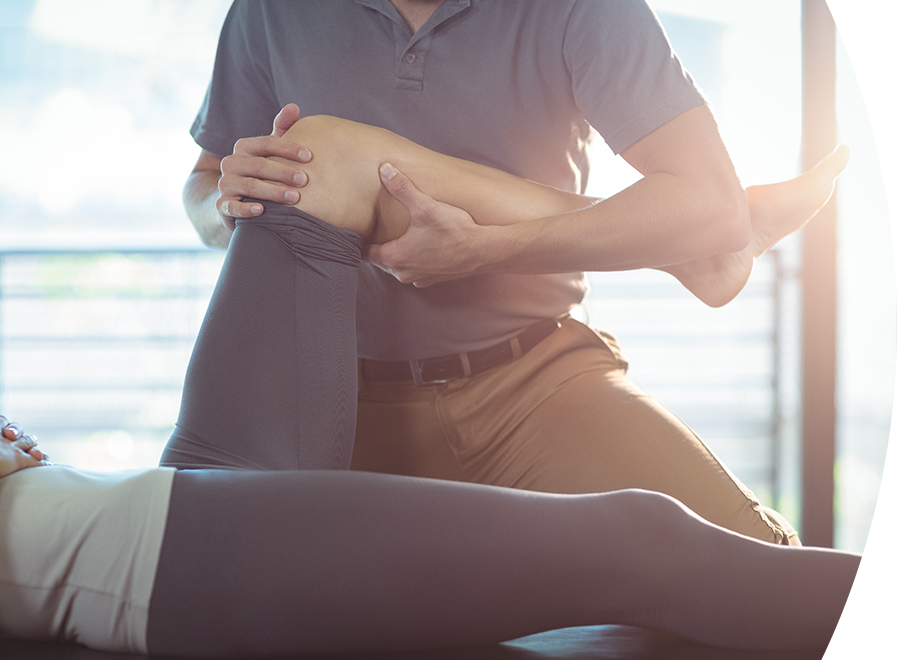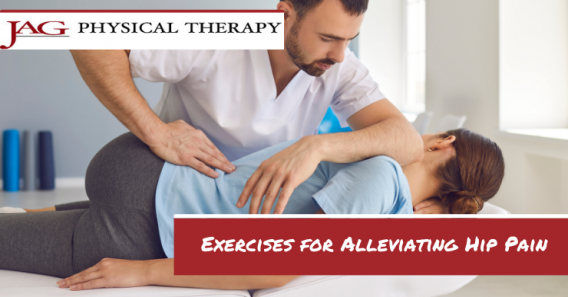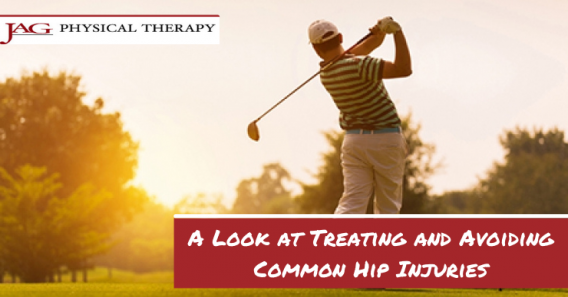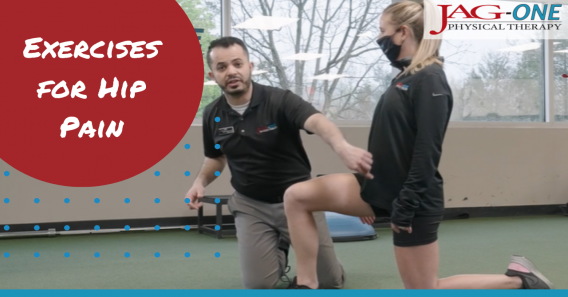The hip is a structurally sound joint that is surrounded and supported by several large structures, including the hamstrings, quadriceps, gluteal muscles, and lower back musculature. This stable structure is not easily injured; however, sport activities, falls, and overuse may lead to an injury. There are also certain diseases (i.e. arthritis) that may lead to hip injuries or further problems and pain in the hip– especially as one ages.
Hip injuries are typically treated utilizing physical therapy. JAG Physical Therapy can be a resource to everyone –from youth athletes to the construction worker- to regain strength and mobility in the hip following an injury. We utilize expert physical therapy methods to achieve favorable results. With over 100 locations in New Jersey, New York, and Pennsylvania, JAG Physical Therapy offers state-of-the-art care for those suffering with a hip injury.
Common Hip Injuries
Explore the common hip injuries below and make an appointment at JAG Physical Therapy to address your hip injury and/or hip pain.
- Labral tear
- Femoroacetabular impingement (FAI)
- Snapping hip syndrome
- Cartilage damage
- Arthritis
- Avascular Necrosis
- Osteonecrosis
- Fracture
Is Physical Therapy Good for Hip Pain?
Physical therapy can help to improve function and mobility in your hips, and in turn, your overall well-being. When it comes to hip pain, whether or not you would benefit from physical therapy depends on your health condition and what’s causing the pain in your hip.
Generally, physical therapy helps improve pain associated with specific hip injuries, as well as mild to moderate forms of arthritis.
What Causes Pain in the Hips?
Hip pain can be excruciating. Most often, it’s due to muscle tightening around the joint within the hip. Sometimes the source of pain is a pinched nerve in the hip area.
Your hip is a ball and socket joint, where one bone sits within another cup-like bone. The hip allows for three degrees of movement: back and forth, side to side, and rotation around. Your muscles connected to the hip pull the bones to make them move.
Because hip movement is so important to everyday mobility, tightening, inflammation, or injury to the hip can be especially painful and restricting.
Physical Therapy Before and After Hip Surgery
Physical Therapy can also be beneficial before and after surgery, helping to ensure a more comfortable and successful recovery process.
Often, a physician will recommend pre-surgical physical therapy to aid in preparing for a smooth procedure. In addition, working with a therapist after hip surgery can ease the rehabilitation and healing process, because your exercise routine will help strengthen the muscles and remove tension around the hip.
Common Injuries to Hip Muscles
The hip is supported by and works in conjunction with other parts of your body. Your lower back, hamstrings, and quadriceps provide additional stability to your hips. While the hip joint is more difficult to injure than other body parts, certain factors can increase the likelihood of injury occurring. Increased risks to hip injuries include sports activities, severe or repeated falls, and diseases that affect bone density like osteoporosis and arthritis.
Common hip injuries and conditions include:
- Bursitis — inflammation of the bursa at the hip caused by muscle rubbing against the femur
- Groin strains — tearing or abnormal stretching of fiber muscles in the groin area
- Labral tear — a tear in the labrum (ring of cartilage) that outlines the hip joint socket
- Femoroacetabular impingement (FAI) — a clinical disorder caused by abnormalities in the hip structure
- Snapping hip syndrome — irregular muscle or tendon movement over the hip bone that causes a snapping sound with certain physical activity
- Cartilage damage — can result from trauma to the hip, degenerative wear, or inflammatory diseases
- Arthritis — joint inflammation and tenderness that causes pain and stiffness and can worsen over time
- Avascular necrosis, aka osteonecrosis — a disease that results in bone death due to low blood supply
- Fracture — a break in the upper portion of the thigh bone
These hip injuries range from minor to severe, as do the symptoms. In most cases, physical therapy is the right course of action, especially if treatment is sought early.
If you are seeking physical therapy for hip pain, contact us, find a location near you, or schedule an appointment at JAG PT today.
Treating Hip Pain at JAG Physical Therapy
When you begin physical therapy at JAG PT, you’ll be evaluated by a licensed therapist first. This evaluation will include assessing your lower and upper body strength, balance, and range of motion. In addition, your physical therapist will consider your current abilities and limitations, needs and desires, and health history.
The result is an individualized treatment plan tailored to your specific case and needs.
How Can Physical Therapy Alleviate Pain?
There are various forms of therapeutic interventions that the expert therapists at JAG PT use to alleviate pain. The most common are stretching and strengthening.
Stretching and strengthening exercises can both optimize flexibility and reduce tightness. Practicing stretches and toning is vital to strengthen muscles and maintain healthy elasticity. Doing so can also improve mobility and reduce pain caused by muscle tightening.
When muscles connected to the hip function properly, they allow for the joint to move in alignment, thus avoiding painful pressure on nerves and other ligaments.
Physical Therapy Exercises to Relieve Hip Pain
Many exercises target hip strengthening to reduce pain. However, if you have severe pain, a known injury, or recently had surgery, it’s crucial to meet with a trained physical therapist before attempting exercises. Your JAG PT therapist will help you determine the best exercises for hip pain relief specific to your needs.
Standard physical therapy exercises for the treatment of hip pain include:
- Stretches such as knee and leg lifts, hip flexor stretch and rotations, and hip abductions and extensions
- Strength conditioning, with or without resistance bands, like squats, butt kicks, pelvis lifts, and planks
- Balance and gait training
- Manual techniques like joint mobilization
Other forms of treatment that physical therapists often use can include hot or cold compression or ultrasonic stimulation. At JAG PT, you'll receive a comprehensive rehabilitation treatment plan that includes whatever exercises are appropriate to your specific condition, that you can do at home and at our facility to maintain mobility.
Relieve Hip Pain Naturally with JAG PT
In many cases, there is no fast way to relieve the pain of a hip injury. Recovery takes time and often requires rest. However, if you are looking for an effective, natural solution to alleviate the pain diminishing your quality of life, JAG Physical Therapy is a resource for you.
We are regional experts and utilize the best physical therapy techniques to help you achieve your recovery goals and get back the life you love.
To get started today, contact us, schedule an appointment, or stop by one of our over 100 New Jersey, New York, or Pennsylvania locations.
RELATED BLOGS & VIDEOS










